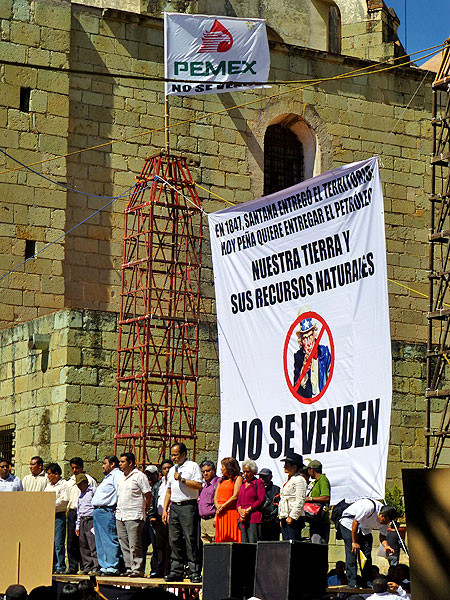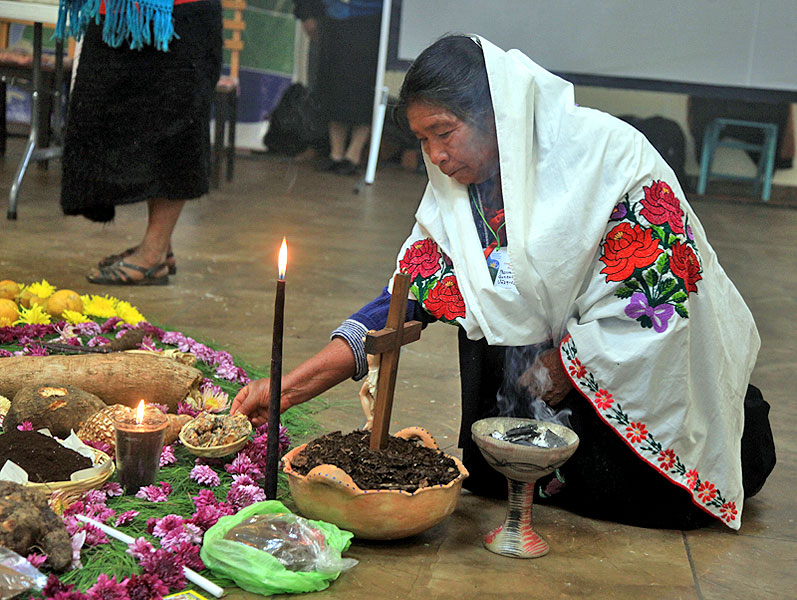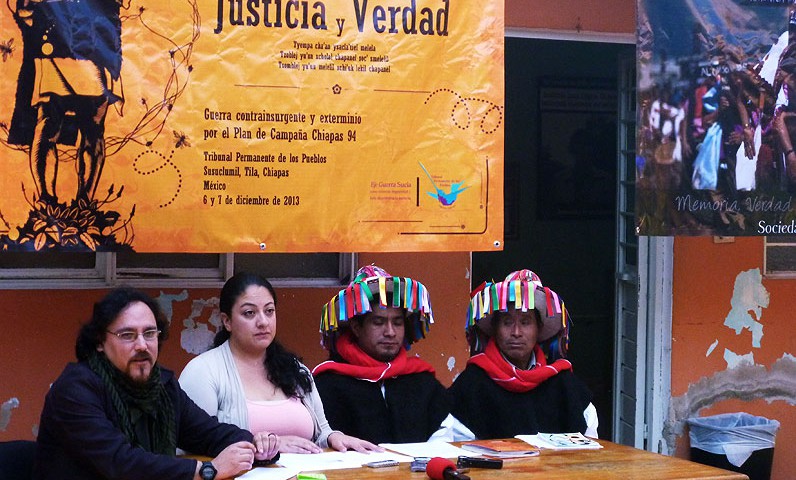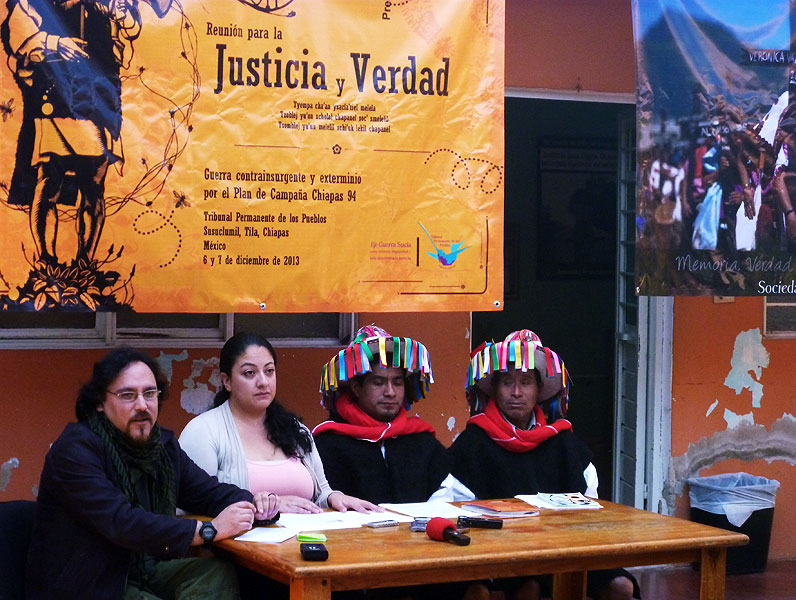
ANALYSIS: First year of Enrique Peña Nieto, with contradictory perceptions of the “Mexican Moment”
21/02/2014
ARTICLE: Pastoral Congress for Mother Earth
21/02/2014Tyempä Cha’an Ysacla’tiel Melelä (Ch’ol)
Tsomblej yu’un melelil xchi´uk lekil chapanel (Tsotsil)
Tzoblej ye´un xcholel chápanel sol´ jmelelil (Tseltal)
On 6 and 7 December 2013, the Mexican State was judged in the community of Susuclumil, Tila municipality, Chiapas, for crimes against humanity during the so-called “dirty war” it launched following the insurrection of the Zapatista Army of National Liberation (EZLN) in 1994, which just celebrated its twentieth anniversary.
The People’s Permanent Tribunal (TPP) is a means the people utilize to denounce and make visible the grave human-rights violations committed by the State which still enjoy impunity, given the exhaustion of established legal mechanisms to realize justice. Its founder, Lelio Basso, as a lawyer committed to justice, took the initiative of carrying out several different actions in favor of oppressed peoples in writing the TPP’s constitution, which was created precisely because in many cases the State and its organs cannot be entrusted with making justice and respecting rights. In October 2011, the Mexico chapter of the TPP was accepted, and its existence will come to an end in 2014. In the state of Chiapas there have been held four pre-audiences on the questions of “femicide and gender violence in Chiapas”; the Acteal massacre; violence against migrants; and lastly, “Dirty war: impunity, violence, and lack of access to justice,” with this last one being carried out in the Susuclumil community, the site of much injustice, death, and persecution.
To Susuclumil came witnesses, survivors, and relatives of victims of the communities of the Northern Zone of the state; communities of Chenalhó, members of the Las Abejas Civil Society from Acteal; and residents of the Viejo Velasco community, Ocosingo municipality.
Counterinsurgent strategy contemplated in the Chiapas Campaign Plan 94
In Susuclumil, the Fray Bartolomé de Las Casas Center for Human Rights (CDHFBC) explained that since the Zapatista uprising, the government had attempted to annihilate the EZLN using three principal means. The first was militaristic, utilizing aerial bombardments against rebel positions; the second with paramilitary groups, by means of campesino structures that represented the strong arm of the Institutional Revolutionary Party (PRI), which held power in those years; and most recently, using public funds thanks to an unprecedented injection of resources to the state, both in infrastructural projects and in social programs, “directed above all to areas where the EZLN has the greatest strength.”
The CDHFBC explained that archives declassified in the U.S. “corroborate the claims of victims and survivors regarding the creation of paramilitary groups.” In 2009, documents from the Defense Intelligence Agency (DIA) reached public light and “describe the role of the Mexican Army in supporting the paramilitary groups in Chiapas.” The secret cables “confirm the reports regarding military support for the armed indigenous groups which carried out attacks against communities sympathizing with the EZLN.” They describe “a clandestine network of ‘human intelligence teams (Humint)’ created at the beginning of 1994 with the support of the president, Carlos Salinas de Gortari, that worked inside of indigenous communities to promote armed anti-Zapatista groups.”
After the Zapatista insurrection of 1994, the entire state of Chiapas was militarized with the support of the Plan for National Defense which legitimized the action of the armed forces amidst an “internal enemy who attacks national security and sovereignty.” The Army worked actively within the project which came to be known as the low-intensity war employing the following characteristics: confusing public opinion at the national and international levels with a peaceful discourse, engaging in social work, limiting confrontations between the two armies, promoting rumors, utilizing the mass media, limiting the possibilities of international observation, and so on; maintaining a military and paramilitary siege of dissident communities; terrorizing civil society and possible EZLN support bases using selective actions; and lastly, by dividing and polarizing communities, repressing and intimidating social organizations, and co-opting and awarding governmental programs to groups allied to hegemonic power.
In Chiapas, militarization continues to be strong to date. Amnesty International claims that 35,000 soldiers are currently engaged at the national level against organized crime. In April 2011, the commander of the Seventh Military Region of Mexico concluded that there were 14,000 soldiers deployed in Chiapas, and that 40,000 had there been stationed in the 1990s.
Norther Zone: acceptance of daily horrors
In geopolitical terms, the Northern Zone was considered a strategic place that joined the zone of Zapatista influence together with the movement of the resistance of the Chontales in the PRD bastion of Tabasco state. This explains the increased militarization of the region, which sought to detain the advance of Zapatismo, as well as the impunity with which the paramilitary PRI group called Development, Peace, and Justice was born and developed.
Violence increased in parallel terms to the electoral campaign of 1995 for mayorships and the state congress, toward the end of intimidating and discouraging the opposition. In the elections, the opposition abstained massively, due both to said violence and the order not to vote as handed down by the EZLN. This led to the PRI’s triumph and the election to Congress of Samuel Sánchez Sánchez, a Ch’ol teacher from Tila and founder of Peace and Justice. Tila City Hall also came to be filled with leaders of the organization, such as Marcos Albino Torres.
During the TPP pre-audience, the indigenous denounced the government’s involvement in the dirty war. One man claimed that “in March 1995 there was founded Peace and Justice. This organization came to be because the PRI members were not in agreement with us: we wanted change, that there be no more injustice, that there be equality, but the government never listened to us. That is the reason for which we were then displaced.”
The voices of the disappeared indicate that the governmental agents “had planned our displacement well in advance. In August 1994, in a meeting with ejidatarios, there was made the agreement. Those who were not part of Peace and Justice had to go, so as to take their lands.” The methods of counter-insurgency included arson of houses and robbery of cattle: “They took all our possessions and we saw how they burned down our homes. To save our lives we had to flee. Our property, crops, everything was lost.” The consequences of the displacement, they say, go farther than just having to leave their homes, whether temporarily or definitively: “We had no freedom of movement. We lived in fear. There was Peace and Justice, federal police, and public security. Those from Peace and Justice took the primary school and there they stayed for four months, accompanied by the federal Army and the police. No one was taken to prison. On the contrary, the police protected them.”
Murders, forced disappearances, and attacks continued apace. In the TPP, a Ch’ol indigenous person explained the case of his father who in 1996 was shot 13 times, 9 in the head and neck. One student recalled the forced disappearance of her father, who was heading to his community in a truck when he was stopped at the curve before the community of Miguel Alemán, where he was told he could not pass because there were too many paramilitaries. In the presence of Diego Vázquez and Nicolás Gómez, leaders of Peace and Justice, he argued that the latter would not touch him. “That day he was disappeared. To date we do not know where he is,” said the student. A man denounced the disappearance of his nephew: “In 1995 we made a legal demand after his disappearance. We sent it to the Public Ministry, but they paid us no heed.”
Another man recalled how his eighteen year-old sister was raped by dozens of men for hours on end, until her body was thrown onto a riverbank. Often, it is women who are the most vulnerable, given that it is they who remain the communities with the children and elderly when the men flee to the mountains. Sexual threats are systematic. One woman expressed that she had not forgotten the death of her husband, who was ambushed in their milpa in 1996. She continues to resist the political parties, and her right to the land is violated, given that her fields have been invaded by relatives of her former husband, “ex-paramilitaries.” Since she is a woman, the authorities do not take her seriously, she observes.
Within the context of the counter-insurgent war, the paramilitaries from Development, Peace, and Justice, with the support and complicity of the PRI government, perpetrated in the municipalities of Tila, Tumbalá, Sabanilla, Yajalón, and Salto de Agua (comprised in their majority of Ch’ol indigenous people), 85 extra-judicial executions, 37 forced disappearances, and the displacement of more than 3,500 persons between 1995 and 2000. During the TPP, those denouncing these crimes requested anonymity given that, even today, they live amidst militarization and paramilitarization, the dirty war, and daily counter-insurgency. A Ch’ol man recalls that the paramilitaries reached his son and shot him in February 1998. The perpetrators belonged to Peace and Justice. “I want those responsible to be punished with jail terms. There can be no reparation of damages; my son is not merchandise,” he declared.
In October 2000, eleven members of Peace and Justice were arrested, including the principal leaders and another nine Ch’ol indigenous men, but they were released less than five months later due to “lack of evidence.” In 2002, Diego Vázquez Pérez was arrested, being another of the main leaders of the group, along with 27 members, including a former PRI official from Tila and the very PRI ex-mayor of Tila. These three persons are the only ones who remain incarcerated to date.
Acteal massacre: chronicle of an announced death
In 1997, violence escalated in the Chenalhó municipality, culminating in the Acteal massacre. Survivors recall that on 22 December of that year, a group of paramilitaries of about 90 in number arrived dressed in black, many of them carrying high-powered rifles which are exclusively for Army use. The massacre lasted more than 5 hours, leading to the death of 45 Tsotsil indigenous persons (18 adult females, four of them pregnant; 7 adult males; 16 female minors, from 8 months to 17 years of age; and 4 male children of between 2 and 15 years) and leaving 26 others injured, the majority of them minors. Several survivors were left with permanent disabilities. Victims found themselves in refuge in the Acteal community due to the continuous harassment perpetrated by armed groups that burned their homes and crops and robbed them of their possessions. The victims were completely unarmed; they were carrying out a day of fasting and prayer for peace in the region. Public security maintained an outpost some 200 meters away from the site of the massacre.
The struggle in the municipality took place between PRI and “Cardenist” militants belonging to the Party of the Cardenist Front for National Reconstruction on one side and Zapatista sympathizers on the other. A third actor victimized by this conflict but that often is not recognized as having a part is the Las Abejas Civil Society, a group that has the same demands as the Zapatistas but that does not support armed struggle.
During 1997, violence was concentrated in the communities surrounding Polhó, an autonomous Zapatista municipality in Chenalhó. It began in May over a conflict for the exploitation of a gravel bank and support for the construction of a road. In some communities, the PRI authorities had demanded cooperation to finance armaments for “self-defense” amidst the growth of the EZLN. Those who refused were kidnapped, beaten, and/or forcibly displaced. In total between 1997 and 1998, 81 persons were killed (20 of them being PRI militants), 37 disappeared, and more than 10,000 displaced.
During the TPP pre-audience, witnesses indicated that the Acteal massacre is a State crime, “because it was ordered from the federal, state, and municipal governments,” as led by Ernesto Zedillo, Julio César Ruiz Ferro, and Jacinto Arias Cruz, respectively. “The mayor in 1997 organized his rural agents, elderly, and caciques to explain that the government said it could not be defeated by the Zapatistas.” Las Abejas explained that the caciques and the PRI mayor initiated “a dirty war, and though we do not have arms, they [said we] were Zapatistas. This was how the massacre was prepared. It began with the burning of homes, robbery, and cooperation for more arms. But we did not accept this, to destroy our comrades. We did not join them, and upon seeing this, they began to displace us,” Las Abejas recalled.
Some days after the massacre dozens of presumed aggressors with PRI and Cardenist affiliations were arrested, as was Jacinto Arias Cruz, mayor of Chenalhó, who was accused of having instigated the crime. Furthermore, the governor of Chiapas, Julio César Ruiz Ferro, and Secretary of Governance Emilio Chuayffet resigned within a climate of accusations for their failures to prevent the massacre. Later, 5,000 more soldiers arrived to Chiapas, with 2,000 of these being stationed in Chenalhó, which became the second most militarized municipality, with 8 Army camps.
Though 87 people were arrested, “the government released them,” as Las Abejas denounced before the TPP. Today the search for justice for the communities of Chenalhó has been met with the release of dozens of indigenous persons accused of having participated in the massacre, not due to innocence but rather because of violations to due process. Now only six persons remain incarcerated for the crime. Beyond being released, moreover, they were “awarded with lands, social projects, compensation of ‘damages,’ and the continuation of the comprehensive war.” Since last August, Las Abejas have denounced that at root of the releases, “the paramilitaries of Chenalhó are now reactivated, firing their weapons and causing displacements, as in the year 1997.” Still today, the consequences of forced disappearance continue to be felt in Chenalhó. Since August 2013, 98 persons from 17 Catholic and Baptist families from the Puebla Colony ejido have transferred themselves to Acteal, where they remain displaced.
Viejo Velasco: yet another case of impunity
© SIPAZ
On 13 November 2006, a massacre was committed in the Viejo Velasco community, Ocosingo municipality, in the Lacandona Jungle, leaving seven persons dead, two disappeared, and 36 displaced, with these remaining displaced to date. The massacre took place because of the operation carried out by state police in Chiapas, with the collaboration of the Organization for the Defense of Indigenous and Campesino Rights (OPDDIC) and residents of the Nueva Palestina community. Viejo Velasco is located at the border of the Montes Azules Biosphere Reserve, a place of great biodiversity and cultural touristic exploitation, given that it finds itself between the Palenque and Yaxchilán archaeological zones, and as such is quite attractive to investor interests.
The acts continue in impunity. In 2007 a civil commission reviewed the site of the massacre and found two human remains, recommending that these be recovered. In 2008 an Argentine forensic anthropological team arrived and declared the recovery of these remains to have been deficient. The State then handed over other remains, an act that was denounced. Later, it transferred the remains in computer casings for burial. As a consequence, several persons were arrested, though no formal arrest-orders have been released.
The organization Maderas del Pueblo del Sureste, 7 years after the massacre, made public a communiqué that indicates that “this bloody event took place within a context of intense struggle and resistance for the right to land and the management of the natural resources of the indigenous communities settled within the heart of the Lacandona Jungle; this resistance confronted an aggressive policy of territorial displacement, social looting, and privatization of nature on the part of the Mexican State, as exercised above all in more than 40 communities located within and on the edge of the Montes Azules Biosphere Reserve, one of the richest zones in terms of biodiversity, water, forest cover, and touristic attraction of our country.”
Popular sentence against the Mexican State
The judges named for the TPP pre-audience on Dirty war: impunity, violence, and lack of access to justice, comprised by personalities with moral authority, declared that, after having heard of the “pain, fear, and injustice of the looting experienced and suffered by the survivors of extrajudicial executions, torture, forced disappearance, forced displacement, sexual violation, looting of resources and land because of the actions of the Mexican government […] the Mexican State is responsible at the three levels of government, from the public state and municipal security forces and the Mexican Army, who provided cover, security, and economic aid to the paramilitary forces, that is to say, to the group known as ‘Development, Peace, and Justice.'” The judges added that “given the evidence accrediting said human-rights violations, it follows that [the State is guilty] of crimes against humanity, including genocidal policies perpetrated against the indigenous Ch’ol, Tsotsil, and Tseltal peoples; these actions continue to the date of the celebration of this pre-audience.”


